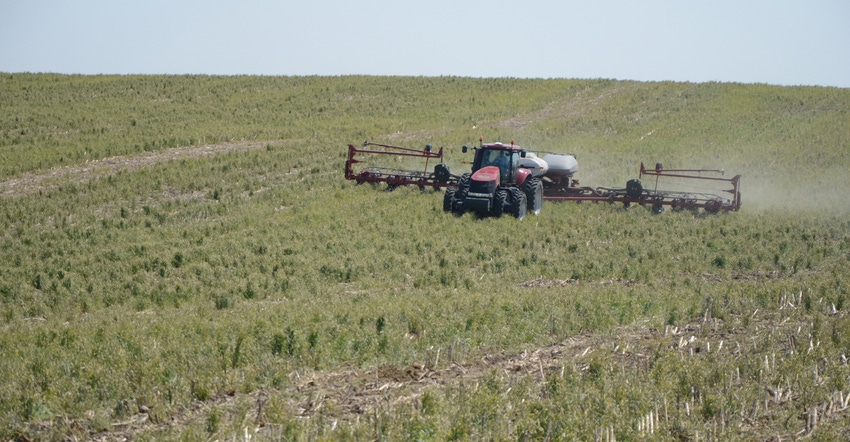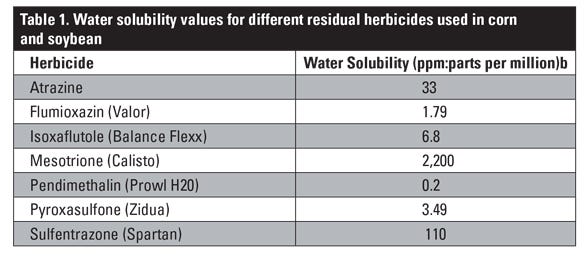May 11, 2020

An increasing number of growers are "planting green" or have asked questions regarding this practice. Planting green means the corn or soybean is planted directly into a growing cover crop (most often a small grain such as rye or wheat) without killing it by herbicide or mechanical means first.
Research on the topic is limited, but a number of growers have posed questions surrounding planting green. Here's a look at what University of Nebraska-Lincoln and Nebraska Extension researchers have learned and observed.
Planting corn into green cereal rye
A rye cover crop can affect corn in several ways, for example by tying up nitrogen, by reducing soil moisture before planting corn, by increasing pest pressure and by allelopathy. Rye, like many plants, releases allelopathic chemicals to defend itself against competition from other plants. These chemicals work by inhibiting the germination and early growth of seeds, which can be seen in the weed suppression potential of rye cover crops.
For several years, we have heard about the potential allelopathy effect cereal rye can have on corn planted into it. To avoid the potential allelopathic effects, often it's recommended to kill the cereal rye at least two weeks before planting corn because of this. But can allelopathic chemicals from rye affect corn?
What we do know is studies investigating whether rye cover crops affect corn germination have mostly been done in laboratory settings. One study found that extracts from allelopathic rye reduced corn root length, but another study found no effects. It is hard to say whether allelopathic effects contribute to slower growth and reduced germination that can sometimes be observed in corn in the field.
For one thing, corn has a large seed, making it less likely to be affected by allelopathic chemicals. Also, allelopathic chemicals quickly degrade in the soil, so a one- to two-week time span between rye termination and corn planting should ensure that there are no allelochemicals in the soil when corn germinates.
Although it is clear that rye releases allelopathic chemicals, we don't know whether it is enough to affect corn. However, there may be some factors that could increase the risk for allelopathy from a rye cover crop:
• Killing rye during early growth stages. Researchers have shown that young rye tissue has higher concentrations of allelochemicals than rye in more advanced growth stages.
• No-till termination of rye compared to tillage-incorporated rye. Incorporation seems to speed up the degradation of allelopathic chemicals.
• If your soils have low silt or low organic matter content. These particles bind allelochemicals, which makes them ineffective.
While the potential effects of allelopathy are worth noting, there are several challenges with terminating rye two or more weeks before corn planting. As we think about the typical growing conditions for cover crops following harvest, there often is little opportunity for much growth going into the winter season. Most of the growth is in the spring.
Killing the rye at least 14 days before planting may not allow for much rye growth or results in delayed planting, either way reducing the potential benefits from cover cropping. In addition, weather conditions have not always been conducive for effective cereal rye termination.
Growers have shared the difficulty of planting through the partially decomposed (described as "mushy") cover crop. Growers also noticed corn planted into these conditions often came up slow and had a yellow, sickly look to it for a time.
Growers that switched to planting green say it was much easier to plant compared with planting into the decomposing, dying cover. They also note the corn also tended to look less yellow or sickly.
Planting soybean into green cereal rye
In a series of studies being conducted in Wisconsin, planting green combined with late chemical termination of cereal rye cover crop (15 days after planting) did not reduce soybean yield as compared to termination at planting time, early termination (15 days before planting) or no cover crop treatments at three locations in the first year of the study.
Moreover, late termination allowed for higher cover crop biomass accumulation, which led to enhanced suppression of troublesome weeds.
Considerations for planting green
In spite of these observations, planting green is not for everyone, and one needs to assess the risk of doing so. To minimize these risks, here are a few practices that have been effective for some growers:
• Apply nitrogen in a starter fertilizer in furrow or 2x2 with corn when planting green. In some cases, it is thought the yellow coloration of corn planted into a cereal cover may be because of nitrogen tie-up rather than allelopathy.
• Wait for the corn or soybean seed to germinate before terminating the cover crop.
• If irrigation is available, have the irrigation system ready to go before planting in the event you need to add some moisture into a dry seedbed.
• Risk Management Agency guidelines allow for planting green and are based on best management practices for different zones and for irrigated or nonirrigated ground. Read more at rma.usda.gov/Topics/Cover-Crops and NRCS Guidelines Version 4.
Risks for planting green
• The growing cover crop will continue to remove moisture until terminated. The seedbed may lack moisture at planting, which is of greater risk for nonirrigated fields and those with irrigation allocations.
• In 2017, wheat stem maggot was an issue in some fields where growers planted green. The frequency of damaged corn plants in fields ranged from 1% to 60% with some farmers reporting losses of 30 bushels per acre in fields with a high number of infested plants. We haven't seen this problem to that extent since. However, it is something for which to be aware. A CropWatch article from 2018 shows photos of wheat stem maggot for scouting purposes. We haven't seen them in the York, Seward and Clay county areas at time of writing this article. Additional photos can be seen in a June 2017 blog post from Jenny Rees.
Herbicide considerations
For green planting, burndown, termination and residual herbicides often are applied at the same time. There are a few factors to consider in this situation. Whenever tank-mixing herbicides, it is important to check herbicide compatibility and antagonism. One example of antagonism is the reduced efficacy of glyphosate that occurs when tank-mixed with atrazine.
It also is important to think about how residual herbicides behave in the environment to optimize their efficacy (Table 1). Residual herbicides require about 0.5 to 1.0 inches of rain or irrigation to move into the soil solution and be available for weed uptake and control.

In addition, herbicide solubility, soil absorptivity, soil pH, soil organic matter, soil microbial activity, precipitation amount and herbicide rate all can affect how long an herbicide persists in the soil. A CropWatch article from 2017 highlights how many of these factors are affected by excessive spring rainfall. In the case of green planting, herbicide solubility is particularly important to consider.
Residual herbicides need to be in the soil to be effective, but when sprayed over cover crops much of the spray falls on the cover crop leaves and residue. In many ways, this is similar to applying residual herbicide on a no-till field with heavy residue. If herbicides have low water solubility, they will tend to remain on plant leaves and residue even after rain or irrigation occurs. However, herbicides with high water solubility will wash off these plant materials and into the soil.
For example, a product such as Calisto has a high water solubility (2,200 parts per million) and would easily wash off cover crop biomass and into soil, but sharpen has a very low water solubility (0.003 ppm) and even with irrigation or high precipitation, would still remain on the cover crop biomass significantly reducing its efficacy in the soil (Table 1).
An observation the past few years is when the full rate of a residual herbicide is applied to taller cereals (12 inches tall or more), the cover crop canopy can reduce the herbicide from getting down to the soil. We've seen weed escapes in these situations. Some growers have found better luck when they apply their residual with their burndown early before the cover gets much growth.
Another consideration would be to split-apply your residual with part at the time you kill the cover and the rest later if a post is needed. Otherwise, the full residual could be applied after the cover has been terminated. The downside is the additional cost of a second pass.
Please share your experiences
Nebraska and Wisconsin farmers were surveyed in early 2020 regarding their successes and challenges from planting green. The target audience was those who already use cover crops. A quick look at the responses show that more than half (53%) of farmers indicated that they used this practice for planting both corn and soybean.
Most farmers reported that they observed none or minor impacts of planting green on crop emergence, yields, allelopathic reactions, pests (disease, insects, weeds) or fertility. We recently conducted a survey of farmers in Nebraska and Wisconsin to learn about their successes and challenges from green planting.
If you have experiences you would like to share, you also can complete the survey.
Rees is a Nebraska Extension educator. Proctor is a Nebraska Extension weed management educator. Koehler-Cole is a research assistant professor in the Department of Agronomy and Horticulture at the University of Nebraska-Lincoln.
Source: UNL CropWatch, which is solely responsible for the information provided and is wholly owned by the source. Informa Business Media and all its subsidiaries are not responsible for any of the content contained in this information asset.
You May Also Like




